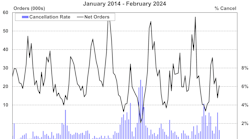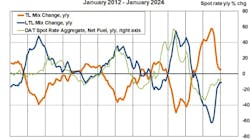FTR’s Trucking Conditions Index (TCI) continued to soften in February due to a weakening of the freight environment early in 2016.
The current reading at 8.27 reflects FTR’s forecast for a slowdown in truck loadings from an average of 4% thus far in the recovery to 2% for full year 2016. There are still positive indicators for trucking including high capacity utilization and positive rate assumptions. The TCI is expected to begin a steady rise heading into 2017 due to expected regulatory capacity constraints and will continue to be positive into 2018 save for the risk of recession or the possibility of temporary spikes in fuel prices reacting to weak U.S. production.
Details of the February TCI are found in the April issue of FTR’s Trucking Update, published April 1. The “Notes by the Dashboard Light” commentary in the current issue addresses durable goods orders and what they mean for the economy. Trucking Update includes data and analysis on load volumes, the capacity environment, rates, costs, and the truck driver situation.
Jonathan Starks, Chief Operating Officer at FTR, commented, “The market has certainly softened in 2016, yet there are still enough positive indicators to keep the freight markets afloat despite the weakness. Freight loads are looking to slow this year, but 2% growth is still a reasonable environment for truck operations. What it doesn’t do is create pressure on capacity, which is what would be needed to improve the rate environment.
“A key focus will be whether the manufacturing sector can stabilize and begin to grow again. I believe it will, but it may still be a quarter or two before fleets start to benefit from that activity. The rate environment has deteriorated but unless the market sinks further we should expect to see contract rates begin improving in the second half of the year. Spot rates have been on a steady decline, but have recently turned back up and should show year-over-year increases sometime this summer. The wildcard right now will be how fuel prices behave.
“The market has had the luxury of operating with decreasing fuel prices. That has now changed and if prices rise quickly it could have a big impact on cash flow, especially for the smaller carriers. If that happens we would expect to see a jump in fleet bankruptcies, something that has remained at historic lows over the last year despite the headwinds that the industry has been facing.”








